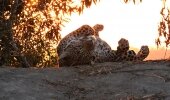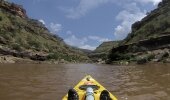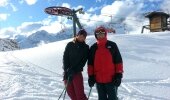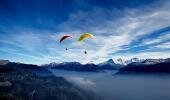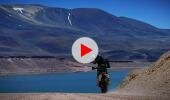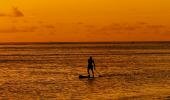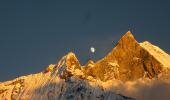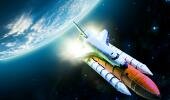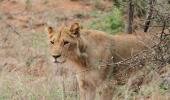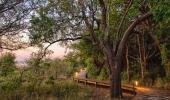Words and Photos: Andre, Pieter, Narine and Carina Troost
With the monsoon season creating havoc, the clouds burst open over a hill. Upon this hill, close to the town of Chalong on Phuket Island, stood a Buddhist temple. I sat inside, cross-legged, next to my mother, father and sister. A euphoric smell of drifting incense stimulated my senses as I stared into the laughing eyes of a golden Buddha statue.
We were introduced to Thailand in the pouring rain and made our way through Phuket’s flooded streets towards Karon Beach; where we were booked in for our five-day stay on the island. After dozing off the effects of jet lag, we hungrily feasted our eyes on our first sights of Asia; a brand new part of our planet’s diversity for us. Roaming through Karon, I noticed familiarity and realised that at that moment I was in commercial Thailand. I was hoping to experience Thailand as a local would and decided to be patient.
We took a taxi to the neighbouring town of Patong, where we were dropped off at the start of one of the pedestrian walkways. As my feet left the car and touched the pavement, I already sensed a feeling in the air that was completely foreign to me. The town appeared to be an independent, living organism. It was 9 o’clock at night and all the clothing shops and stalls were still open and hustling for business, while vibrant bars and restaurants lined both sides of the outstretched street. In the middle of this electrifying atmosphere, I delighted my taste buds with snapper fried in one of the hottest curries I have ever tasted. However, I also experienced an unwholesome part of Thailand in Patong; the overwhelming presence of the sex trade on the streets, which was obnoxious to say the least. The shocking part is that it is brazenly displayed for everyone to see.
This experience created conflicting thoughts in my head that caused me to question my perceived wholesomeness of Thailand. It seemed that Phuket, and Patong in particular, had become a haven for Westerners to liberate their temptations and desires, which definitely diminished the wholesomeness that I was expecting.
That being said, there are still places on the island where one doesn’t have to succumb to commercial tourism. For the remainder of our time in Phuket, we explored the spots that remained unaffected. We headed to the gypsy village of Rawaii, probably one of the last remaining ethnic Thai villages on the island. My patience had indeed been rewarded. Here you can buy seafood from the locals and take it to a local restaurant in the village. They then cook it for you while you relax over a beer and familiarise yourself with how daily life in the village unfolds. As we sat on the porch of the restaurant, we met a journalist from Bangkok, who was busy investigating a legal dispute between the villagers and a property developer who states that he rightfully bought the land. Apparently, he wants to build a holiday resort. Even though the villagers rely heavily on tourists for their daily bread, it would be a pity if yet another village had to yield to the plague of holiday resorts.
Thailand’s biodiversity is the kind that one doesn’t get to see often, especially the limestone islands in Phang Nga Bay. The most famous must be Khao Ping Ghan, also known as James Bond Island, as this is where the 1974 motion picture The Man with the Golden Gun was shot. These islands are something quite spectacular! We were also lucky to visit the unique town of Koh Panyee, an Islam sea village built on water with the aid of stilts.
At the end of our five-day stay in Phuket we boarded Thai Airlines for Bangkok. Judging by my first view of the city, I knew this was going to be the highlight of my visit to Thailand. And it was! Motorcycles squeezing through the smallest of spaces, indigenous fast food and golden Buddha statues on the pavement, humid weather and every second person offering one a lift on a ‘tuk-tuk’ ensured a culture shock, which I believe is an essential part of travelling to foreign lands. This culture shock created a feeling that I’ve never felt before and one that I will never feel again, unless I find myself in this city once more. Only when I took the elevator to the 78th floor of the Baiyoke Sky Tower, the tallest building in Thailand, did I really grasp how big Bangkok was. As I sat down to a delicious buffet next to a small, chubby Asian boy stuffing his mouth with dumplings, I sipped on my Singha beer contently. As I took in the 180-degree view of the Bangkok night sky, I pondered how easily this amazing foreign place had delivered me into my comfort zone.
We spent our remaining two days visiting the Temple of the Emerald Buddha, known in Thai as the Wat Phra Kaew, and took a boat down the Chao Phraya River and its canals. This was a really insightful experience as the canals made it possible to see the city from an entirely different angle. After all, Bangkok is known as the ‘Venice of the East’ and it certainly lived up to its reputation. We visited the Floating Market the following day, which was a big disappointment and definitely the worst part of the trip. The ‘market’ was just a few Thai locals paddling around and selling fake, over-priced souvenirs. On top of that, we spent about three hours on the road getting there and back to Bangkok.
My last remaining expectation of Thailand had backpacking written all over it. So I took my uncle’s advice and headed to Khao San Road, apparently a backpacker’s paradise. I soon realised that I hadn’t been dropped off at Khao San. After walking from street to street with a vision of a backpacker paradise in my mind, I came around a corner and knew I was finally in the right place. Strolling up the street, I experienced first-hand how overwhelmed Richard, Leonardo di Caprio’s character in the motion picture The Beach, must have been by this ‘anything goes’ environment. It is easy to see how someone can get lost in a place like this. The street is a kilometre in length, filled with budget guesthouses, bars, shops, tattoo shops, massage parlours and stalls. The concept is similar to Patong in Phuket, but it has a different touch as the atmosphere here is alternative and arty. It has to be said though that in recent years, Khao San Road has become mainstream and very overcrowded as more and more people came to hear about it. Luckily for the alternative traveller or just a traveller wanting to experience something more stripped down there is Soi Rambuttri. There is a laid-back, non-mainstream vibe to be enjoyed here and the street gives you a glimpse into what Bangkok used to look like before its rapid economic growth.
When I opened my eyes again it was time to head back home to South Africa. While sitting in Terminal 2 in Singapore’s airport, I reflected on my journey. Travelling is more than just the thrill of seeing sights that most people do not get to see, it shows you how the day-to-day scenes of other cultures elapse. It teaches you that the world really is a big place and that the more you get to see of it, the smaller you feel. And when you feel small, you perceive everything around you as being significant. Thus, in the end, travelling teaches you to take more notice of everything around you. As Westerners it is essential for us to travel to the East, as it creates a paradigm shift in our minds. It is something so massive in terms of demographics and so different from what we are used to that it enables us to experience a fuller picture of the world we live in.
